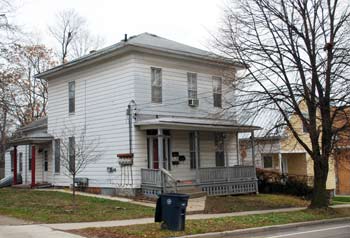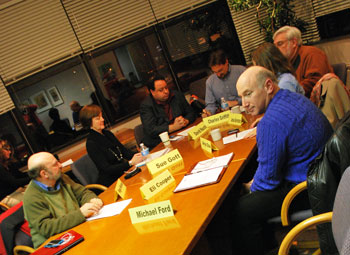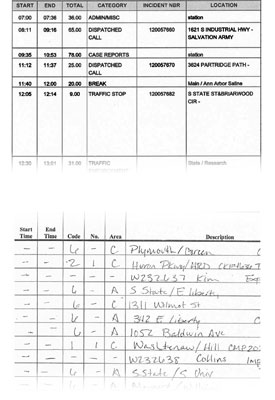Washtenaw County board of commissioners meeting (Jan. 2, 2013): The first meeting of 2013 reflected a mix of celebration as well as some tensions on the newly constituted nine-member board.

Declan LaBarre, son of Andy and Megan LaBarre, was the youngest of many family members who attended the Jan. 2, 2013 meeting of the Washtenaw County board of commissioners to watch the new board get sworn in. Andy LaBarre is the newest Ann Arbor commissioner, elected on Nov. 6 to represent District 7. (Photos by the writer.)
After the swearing-in of commissioners – a ceremony officiated by county clerk Larry Kestenbaum – the two main agenda items were the election of board officers, and approval of revised board rules and regulations.
Two of the four new board officers are from Ann Arbor: Yousef Rabhi (D-District 8), who was elected chair of the board on an 8-1 vote, with Dan Smith (R-District 2) dissenting, and Andy LaBarre (D-District 7), who was unanimously elected chair of the board’s working sessions.
In explaining his vote against Rabhi later in the meeting, Dan Smith cited the previous tradition of rotating the chair position between Ann Arbor representatives and commissioners from the out-county area, to ensure that all voices are well-represented in all aspects of county business. Smith’s district covers some of the county’s more rural townships, including the townships of Webster, Northfield, Salem. The chair for the previous two years, Conan Smith (D-District 9), is also from Ann Arbor.
Dan Smith said it was especially troubling to have another Ann Arbor chair because Ann Arbor districts have declined proportionately to the rest of the districts – decreasing from four districts on an 11-district board to three districts on a 9-district board, because of redistricting.
Responding to those concerns, Conan Smith said he never liked the tradition of rotating chairs on the board, and felt they should choose the right person for the times. Rabhi said he hoped to set a tone of collaboration and cooperation, and looked forward to working with Dan Smith and other commissioners to help achieve their goals for the county.
Also elected were Alicia Ping of Saline (R-District 3) as vice chair and Felicia Brabec of Pittsfield Township (D-District 4) as chair of the board’s ways & means committee. Dan Smith also dissented on the election of Brabec.
The first meeting of each year includes a review of the rules and regulations that govern the board’s actions. The major change, on a 5-4 vote, was to remove the ability of a commissioner to abstain from a vote. The amendment to strike the rule was put forward by Conan Smith. Others voting in favor of the deletion were Kent Martinez-Kratz (D-District 1), Felicia Brabec (D-District 4), Rolland Sizemore Jr. (D-District 5), and Yousef Rabhi (D-District 8).
The question of abstaining from votes typically relates to resolutions on state or federal issues, over which the county board has no control. This year, the county board already appears to be moving to weigh in on at least one state-level issue. The board called a special working session for Jan. 3 to discuss the state’s new “right to work” law, which was passed during the legislature’s lame duck session late last year and signed into law by Republican Gov. Rick Snyder. That meeting will be covered in a separate Chronicle report.
The Jan. 2 board meeting also included an update on negotiations about the county’s contract with the Humane Society of Huron Valley (HSHV). The agreement, which hasn’t yet been finalized, would pay HSHV $550,000 annually to provide animal control services to the county over four years. Of that, $460,000 would come from the county’s general fund. The remaining amount would be paid through contracts with other municipalities that have animal control ordinances: the cities of Ann Arbor and Ypsilanti, and the townships of Pittsfield, Superior and Ypsilanti. County administrator Verna McDaniel said she’s already had discussions with those entities, as well as with the city of Saline.
Some commissioners expressed concerns about the Humane Society contract. Rolland Sizemore Jr. objected to HSHV receiving amounts over $550,000 if new revenue is brought in – because he felt the revenue should come back to the county instead. Ronnie Peterson worried about the additional financial burden that just a few municipalities would bear, and wanted to see every municipality help pay for animal control services. The new contract with HSHV is expected to be finalized later this month, and does not require board approval. [Full Story]









